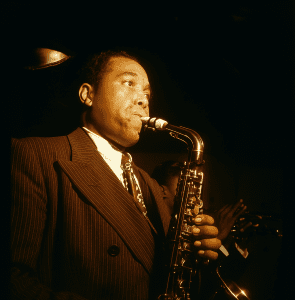Another great article on the current New Orleans music and culture scene from Larry Blumenfeld.
This one about Donald Harrison Jr. and Mardi Gras “Indian” culture appeared recently in the Village Voice.
Mardi Gras Indian Chiefs Stand Spectacular, Tall, and Proud
Doing their part to keep New Orleans culture alive
“It’s amazing how much joy and hope these beads and feathers bring.”
The Sunday before Mardi Gras in New Orleans, Donald Harrison Jr., Big Chief of the Congo Nation, son of Big Chief Donald Sr., lay on the living-room floor of his mother’s house in the Ninth Ward, cutting leopard-print fur in a pattern as he spoke. Nearby, a sofa and chair were covered with beads and rhinestones, along with ostrich and turkey feathers that had been dyed a golden yellow. Harrison was preparing to “mask,” to enact the city’s least-understood tradition, and these days, perhaps, its most essential: Mardi Gras Indian culture. These rituals, which date to at least the mid-1800s, are an African-American homage to the Native Americans who once sheltered runaway slaves and to the spirit of resistance.
The calendar was pointed in its irony this year: Elsewhere, February 5 marked Super Tuesday. All attention was squared on would-be elected leaders with practiced battle cries, competing to prove themselves fierce and attractive. But in New Orleans, Super Tuesday was Fat Tuesday. Uptown, in the limelight, the various well-publicized krewe parades (a throng that included Hulk Hogan, King of Bacchus) lorded over the city, riding high on floats and tossing down beads. But on less-traveled streets, more in the shadows and announced mostly on a need-to-know basis, Mardi Gras Indian Chiefs, possessors of strictly inherited thrones, asserted their authority. Dressed in 10-foot-tall, 6-foot-wide feathered and beaded suits and accompanied by “queens,” “spy boys,” and others, they were announced by drumbeats and chants, lending voice and hope to New Orleans residents who’d been all but ignored this primary season. The Big Chiefs competed with words, too. And in a ritual that once frequently did turn violent, they battled to win hearts and minds, competing through elaborate suits to “kill ’em with pretty.” The presidential candidates were selling change, but in New Orleans, a city all but ignored by that lot (except for John Edwards, who stood in front of the Ninth Ward’s Musician’s Village as he dropped out of the race), the message from these local leaders was continuity.
Sunday night, when most Americans were watching the Giants and Patriots do battle, Big Chief Darryl Montana of the Yellow Pocahontas-son of Allison “Tootie” Montana, known as “chief of chiefs”-was completing his own suit out in Kenner, the suburb he’s called home since Katrina drove him out of the city. Such work is all-consuming, not to mention expensive and physically demanding. It’s not uncommon for a chief’s hands to be scarred from needle cuts; while affixing one section of his crown to its backing, Montana had run a drill into his finger.
The brass-band second-line parades endemic to New Orleans culture draw on the same African-rooted bamboula rhythm as do Mardi Gras Indian chants, derived from Congo Square, where enslaved Africans were once permitted to dance and drum on Sundays (and for which Harrison’s tribe is named). These days, that site, on the fringe of the French Quarter, sits behind a gate to Louis Armstrong Park that’s been nearly always locked since Katrina. On Lundi Gras, the Monday before Mardi Gras, the New Orleans Social Aid & Pleasure Club Task Force, representing some 30 clubs, held its third-annual unified parade at that spot. The police had tried to cancel the event just days earlier, the latest in a series of city-sponsored challenges to this tradition. But aided by the ACLU, the Task Force took the city to federal court-the second time in a year that they’ve resisted and scored a legal victory. The clubs were saying, in effect, what the Indians sing in their traditional song “Shallow Water”: “We won’t bow down.”
Early Mardi Gras morning, I was back in the Ninth Ward, waiting for the Young Guardians of the Flame, led by six-year Big Chief Kevin Cooley Jr. and organized by Cherice Harrison-Nelson, Donald’s sister. This year, Cherice wore orange, red, and yellow. Last year, her suit was emblazoned with a beaded likeness of her father; above it, covering her heart, was a beaded American flag, its stars represented by crystals shaped like tears. “Something deep within your soul calls you to do this,” she said. “And you’ve got to do it, for your mental and physical survival, and for the welfare of those around you.”
Midday, Victor Harris of Fi-Yi-Yi showed up in front of the home of Joyce Montana, Tootie Montana’s widow. I recalled how he’d looked fierce in his African-inspired green-and-red mask two years ago, when the wake of Katrina threatened to swallow all such traditions. “They spit us all over this land,” he shouted then, amid drumming. “They told us we had to evacuate. But they didn’t say we had to stay away.” Now, Indians in a rainbow of colors passed through, did mock battle, embraced, moved on. A small crowd had assembled. Around 3 p.m., Darryl Montana came out of Joyce’s front door, looking regal in his tall, broad, lavender, feathered suit, which rippled gently in the growing breeze as he headed up to Claiborne Avenue, where Indians generally convene on Mardi Gras, beneath the overpass for I-10-“Under the Bridge,” as they call it.
That phrase holds a different meaning these days, as it did splashed across the cover of the local weekly, Gambit, headlining a piece about the growing encampment of some 200 homeless underneath the freeway, just a small portion of an estimated 12,000 cast-out residents. And not far from view on Claiborne was the darkened façade of the Lafitte Housing Projects, its doors and windows covered with steel plates. It seemed a cruel indignity, some mash-up of Dickens and Orwell, when, five days before Christmas last year, the New Orleans City Council unanimously approved a HUD-ordered plan to tear down some 4,500 units of public housing. I was in New York, watching CNN as residents assembled outside by barricades and police lines. “If you know New Orleans, you’ll know how dilapidated these housing developments are,” said anchorwoman Kyra Phillips. “They’ve been crime-ridden, very popular for drug-running. . . . According to the mayor, this is an effort to clean up the city, have better housing for folks.”
Meanwhile, like some bizarre B-roll footage, we saw a live shot of New Orleans residents being turned away with pepper spray; one woman fell to the ground after being Tasered. But we heard only Phillips. The residents were voiceless, as they’d been in the debate about demolition and rebuilding of public housing in a city hard-pressed for affordable homes. On Mardi Gras morning, Gerard Lewis, Big Chief of the Black Eagles, led his tribe in a prayer outside the B.W. Cooper projects-once their coming-out spot, now slated to be destroyed.
As the week rolled on, and Super Tuesday’s primary results proved inconclusive, sure enough, New Orleans made its way into the election-year discourse. “Suddenly, candidates are paying attention,” read the subhead to Thursday’s front-page coverage in The Times-Picayune. Barack Obama spoke at Tulane University that day, mentioning slaves at Congo Square and their “dances of impossible joy,” but not public housing. However, the subject was raised later in the day at the Ogden Museum of Southern Art, in a panel discussion of architects who bemoaned the loss of sturdy and historically significant structures.
>From the audience, historian Nick Spitzer commented, “Let’s not lose sight of these as what they are: homes.” Marshall Truehill, pastor of the First United Baptist Church and former chairman of the city’s planning commission, mentioned how much the housing projects meant to Mardi Gras Indian culture and vice versa. “When you destroy neighborhoods, you tear apart a culture too,” he said. “Once you tear down these buildings, you can’t put them back.”
The next day Jerome Smith, an activist who runs the Tremé Community Center, compounded the thought: “Even though we had a good turnout for Mardi Gras, it’s not the same, and I wonder if it ever will be. The great sorrow is that the people from those projects, especially the children who have been cast out of this city, can’t receive those rituals they way they’re supposed to.”
The Sunday before Mardi Gras, Donald Harrison had told me he was going to wear his suit, but that he would stay close to home, holding court as it were. He wasn’t going to take to the streets, to “come out.” I told him I didn’t believe him. “Wasn’t ritual important?” I asked.
We waited and waited, a group of us, in front of the Holy Faith Temple Baptist Church on Governor Nicholls Street. Finally, near dusk, Harrison arrived, driving a yellow Penske truck filled with the parts of his suit. As the sky darkened, he made his entrance from church to street, arms folded, concealing the detailed beadwork in the image of his father, feathers rippling as he walked, chants and beats following him. He looked spectacular, and moved tall and proud.
The following weekend, he was playing saxophone alongside pianist Henry Butler. Harrison, who is not only a Big Chief but also a world-class jazz musician, talked to me beforehand about the connections between Mardi Gras Indian rhythms and the drumming of Art Blakey, his early employer. He related the beadwork of his suit to the intricate patterns in the Afro-Caribbean music of pianist Eddie Palmieri, whom he was about to join on tour. He spoke of the lessons of leadership he soaked up as a Big Chief, which he passes on to the musicians he teaches through the local Tipitina’s Foundation.
“So you came out after all,” I said.
“Yeah,” he shot back. “Ritual matters.”
Since Katrina, Harrison’s attitudes have transformed. He’s no longer comfortable with the term “Indian,” which is a complicated matter. But his purpose remains clear. “I’m going to continue to mask in beads and feathers,” he added. “I’m going to play my saxophone. If enough people do their part, everything will endure. But that’s the question: Will people be allowed to do their part?”






